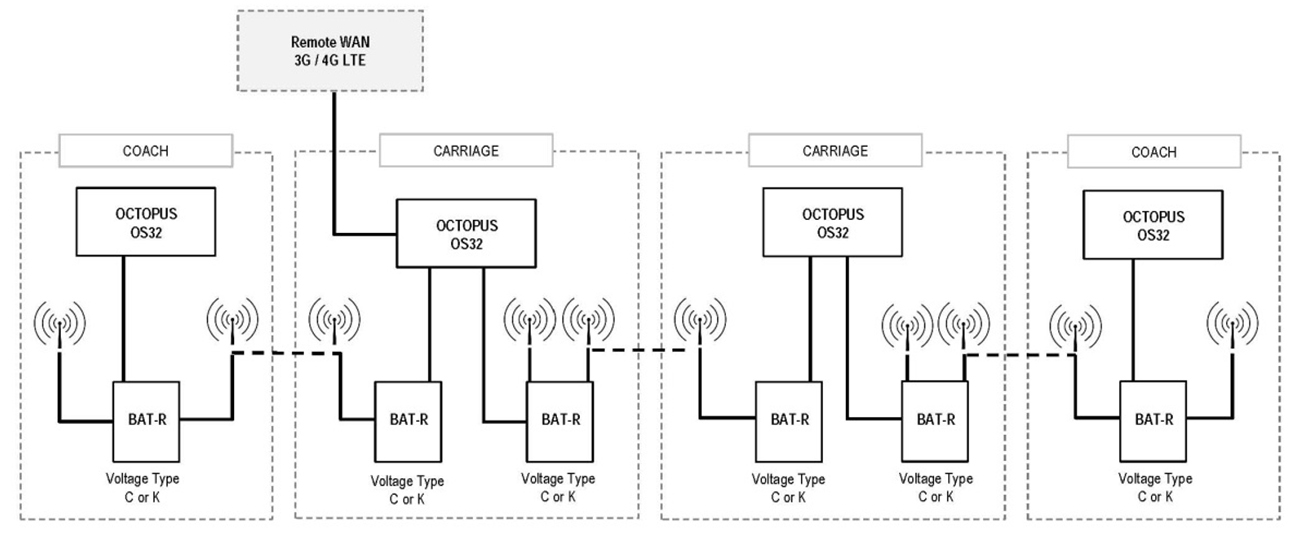Industrial Wireless Network Design for Railways
Just as industrial automation systems in plants are migrating from fieldbus to Ethernet, so too are the networks that control modern transportation systems. Let’s think for a moment about railway systems, which include everything from subway or metro systems in cities to light rail networks in major urban areas to high-speed trains connecting states or countries.
New requirements such as passenger demands for Internet access, the need for flexible train re-configurations and ever increasing productivity demands are driving rail organizations to adopt industrial Ethernet. While traditional fieldbus technology is simple and very reliable, Ethernet offers the benefits of flexibility, ease-of-use and real-time communication.
Needless to say, safety and reliability are of paramount importance for transportation systems. How then can Ethernet systems, especially when they incorporate industrial wireless technologies, meet both application needs and high reliability requirements?

Industrial wireless systems for railways attract passengers, enhance productivity and speed up train re-configurations.
3 Trends Driving Industrial Wireless Technology for Railways
- The ability to provide onboard wireless Internet access for passengers is a key trend driving railroad adoption of industrial wireless Ethernet technologies. Not only do today’s commuters and travelers want Wi-Fi, having it increases passenger loads. Ethernet connectivity also facilitates the delivery of real-time arrival and connection information.
- Trains are often re-configured to maximize profit and keep costs down. For example, groups of rail cars are added together during rush hour and then removed during low periods. Coupling and de-coupling rail cars can be difficult and time consuming, but wireless technology makes the process faster and safer.
- To ensure passenger trains perform as expected, data collection and monitoring must occur across a range of onboard, depot and centralized systems. Industrial wireless technology makes this possible and provides productivity gains in the areas of fuel efficiency, reliability, plus reduced diagnostic and maintenance costs. Other benefits include enhanced security (via surveillance cameras), shorter dwell times at platforms and reduced headway between trains.
While industrial wireless brings significant benefits, the network design challenge is to ensure uncompromising traffic safety and high-availability networks. In addition, communications systems must meet stringent specification and certification requirements. Standards vary by region; the white paper available for download contains a good summary of them.
Factors to Consider in Network Design
Harsh Environment
Determine the IP rating the wireless and other network equipment will need to meet. For example, what level of water resistance, what temperature range and what level of electrostatic discharge must be handled for the rail system under consideration?
Redundancy Measures
Reliability is paramount and trains need fail-safe measures to keep their industrial network up and running. For wireless specifically, products with built-in parallel redundancy protocol (PRP) dramatically improve the reliability and quality of wireless connections. PRP is the vital key to achieving the loss and latency-sensitive application requirements of the railway industry.
If you are not familiar with PRP, see the white paper and articles we have on the topic, available in links at the end of this article.
Centralized Network Management
Consider the importance of selecting wireless networking equipment that enables remote monitoring and management from a central location. Network management software, for example, can recognize the topology of a train’s onboard network and use the information to assign numbers to rail cars and even specific seats.
Safety and Security Factors
IP-based cameras at platforms or the front of the train play a major role in enhancing passenger safety and the security of a train’s network. To provide this, specify wireless access points for secure transmission of video information and connect them to Power over Ethernet-capable switches for installation simplicity and cost effectiveness.
Wireless Technology Standards
In addition to meeting the country certifications for the railroad’s operating area, make sure the wireless technology selected meets the IEEE 802.11n transmission standards. This standard greatly improves application reliability.
Future Expansion
A well planned and segmented Ethernet network design provides expansion and flexibility benefits. Use your skills here to make sure that as data speeds increase or programming needs change, the communication infrastructure can readily adapt.
Retrofitted Industrial Wireless Network for Onboard Railway System

Simplified network diagram for an industrial wireless system installed onboard trains. Its design and choice of equipment achieve very high safety and reliability requirements.
The figure above depicts a typical wireless network configuration in an onboard railway system. In this scenario, the rail operator sought fast and reliable transmission of operational data and passenger information via an industrial Ethernet infrastructure, plus the interconnection of multiple onboard systems via fast Ethernet switches.
The operator was faced with several challenges for this application, including the need for data connections between rail cars with speeds in excess of 100Mbps and keeping installation to a minimum with little to no impact on existing wiring.
As pictured, the network was segmented into several zones based on physical parameters and each zone is supported by one or two wireless access points (OpenBAT-R) and one industrial Ethernet-managed Gigabit switch (OCTOPUS OS32).
The access points selected offered dual wireless modules, and in some cases, were able to be used for both internal Wi-Fi services and communications between rail cars. This dual function helped minimize potential installation challenges.
Using wireless technology for car-to-car communication is an ideal solution for retrofitting Ethernet services on board trains. Since there is no need to modify the existing car-to-car wiring, costs can be kept low and subsequent safety certifications more straightforward to secure.
The managed Gigabit switches used in this application had Power over Ethernet (PoE) capabilities and were therefore able to power the wireless devices directly over Ethernet. This eliminated the need to install power supplies and cabling for the wireless devices, which also made installation simpler and reduced costs.
The switches also provided local wired connectivity within each rail car for all other Ethernet-based services and applications. With the ability to support up to two Gigabit ports each, the switches will be able to accommodate future data rate increases.
Ultimately, the combination of thoughtful network design and the right products helped this rail operator update and future-proof its network. Tapping into the latest wireless technology made it possible to circumvent the challenges and achieve the defined networking and connectivity goals.
High Reliability Is Achievable
Industrial wireless systems based on Ethernet technologies offer significant benefits to railway systems. The key to realizing the benefits AND meeting the high reliability and safety standards required is to use networking equipment.
Network Equipment for Railways Must Include:
- The IP ratings necessary for proper functioning in the railroad’s physical environment
- The certifications and approvals needed for the country of operation
- PRP capable switches and wireless devices
- IEEE 802.11n compliance
- Easy integration with network management software
In addition, make sure that the network is well designed and segmented to allow for future growth and flexibility.
